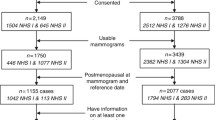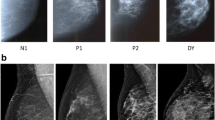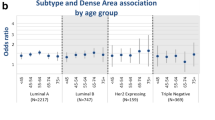Abstract
Mammographic density is a strong risk factor for breast cancer but its underlying biology in healthy women is not well-defined. Using a novel collection of core biopsies from mammographically dense versus non-dense regions of the breasts of healthy women, we examined histologic and molecular differences between these two tissue types. Eligible participants were 40 + years, had a screening mammogram and no prior breast cancer or current endocrine therapy. Mammograms were used to identify dense and non-dense regions and ultrasound-guided core biopsies were performed to obtain tissue from these regions. Quantitative assessment of epithelium, stroma, and fat was performed on dense and non-dense cores. Molecular markers including Ki-67, estrogen receptor (ER) and progesterone receptor (PR) were also assessed for participants who had >0% epithelial area in both dense and non-dense tissue. Signed rank test was used to assess within woman differences in epithelium, stroma and fat between dense and non-dense tissue. Differences in molecular markers (Ki-67, ER, and PR) were analyzed using generalized linear models, adjusting for total epithelial area. Fifty-nine women, mean age 51 years (range: 40–82), were eligible for analyses. Dense tissue was comprised of greater mean areas of epithelium and stroma (1.1 and 9.2 mm2 more, respectively) but less fat (6.0 mm2 less) than non-dense tissue. There were no statistically significant differences in relative expression of Ki-67 (P = 0.82), ER (P = 0.09), or PR (P = 0.96) between dense and non-dense tissue. Consistent with prior reports, we found that mammographically dense areas of the breast differ histologically from non-dense areas, reflected in greater proportions of epithelium and stroma and lesser proportions of fat in the dense compared to non-dense breast tissue. Studies of both epithelial and stromal components are important in understanding the association between mammographic density and breast cancer risk.

Similar content being viewed by others
References
Cummings SR, Tice JA, Bauer S, Browner WS, Cuzick J, Ziv E, Vogel V, Shepherd J, Vachon C, Smith-Bindman R et al (2009) Prevention of breast cancer in postmenopausal women: approaches to estimating and reducing risk. J Natl Cancer Inst 101:384–398
Vachon CM, Brandt KR, Ghosh K, Scott CG, Maloney SD, Carston MJ, Pankratz VS, Sellers TA (2007) Mammographic breast density as a general marker of breast cancer risk. Cancer Epidemiol Biomarkers Prev 16:43–49
Boyd NF, Martin LJ, Bronskill M, Yaffe MJ, Duric N, Minkin S (2010) Breast tissue composition and susceptibility to breast cancer. J Natl Cancer Inst 102:1224–1237
McCormack VA, dos Santos Silva I (2006) Breast density and parenchymal patterns as markers of breast cancer risk: a meta-analysis. Cancer Epidemiol Biomarkers Prev 6:1159–1169
Boyd NF, Jensen HM, Cooke G, Han HL, Lockwood GA, Miller AB (2000) Mammographic densities and the prevalence and incidence of histological types of benign breast disease. Reference Pathologists of the Canadian National Breast Screening Study. Eur J Cancer Prev 1:15–24
Li T, Sun L, Miller N, Nicklee T, Woo J, Hulse-Smith L, Tsao MS, Khokha R, Martin L, Boyd N (2005) The association of measured breast tissue characteristics with mammographic density and other risk factors for breast cancer. Cancer Epidemiol Biomarkers Prev 14:343–349
Hawes D, Downey S, Pearce CL, Bartow S, Wan P, Pike MC, Wu AH (2006) Dense breast stromal tissue shows greatly increased concentration of breast epithelium but no increase in its proliferative activity. Breast Cancer Res 8:R24
Stomper PC, Penetrante RB, Edge SB, Arredondo MA, Blumenson LE, Stewart CC (1996) Cellular proliferative activity of mammographic normal dense and fatty tissue determined by DNA S phase percentage. Breast Cancer Res Treat 37:229–236
Alowami S, Troup S, Al-Haddad S, Kirkpatrick I, Watson PH (2003) Mammographic density is related to stroma and stromal proteoglycan expression. Breast Cancer Res 5:R129–R135
Bartow SA, Pathak DR, Mettler FA, Key CR, Pike MC (1995) Breast mammographic pattern: a concatenation of confounding and breast cancer risk factors. Am J Epidemiol 142:813–819
Lin SJ, Cawson J, Hill P, Haviv I, Jenkins M, Hopper JL, Southey MC, Campbell IG, Thompson EW (2011) Image-guided sampling reveals increased stroma and lower glandular complexity in mammographically dense breast tissue. Breast Cancer Res Treat 128:505–516
Boyd NF, Byng JW, Jong RA, Fishell EK, Little LE, Miller AB, Lockwood GA, Tritchler DL, Yaffe MJ (1995) Quantitative classification of mammographic densities and breast cancer risk: results from the Canadian national breast screening study. J Natl Cancer Inst 87:670–675
Bright RA, Morrison AS, Brisson J, Burstein NA, Sadowsky NS, Kopans DB, Meyer JE (1988) Relationship between mammographic and histologic features of breast tissue in women with benign biopsies. Cancer 61:266–271
Fisher ER, Palekar A, Kim WS, Redmond C (1978) The histopathology of mammographic patterns. Am J Clin Pathol 69:421–426
Verheus M, Maskarinec G, Erber E, Steude JS, Killeen J, Hernandez BY, Cline JM (2009) Mammographic density and epithelial histopathologic markers. BMC Cancer 9:182
Harvey JA, Santen RJ, Petroni GR, Bovbjerg VE, Smolkin ME, Sheriff FS, Russo J (2008) Histologic changes in the breast with menopausal hormone therapy use: correlation with breast density, estrogen receptor, progesterone receptor, and proliferation indices. Menopause 15:67–73
Khan QJ, Kimler BF, O’Dea AP, Zalles CM, Sharma P, Fabian CJ (2007) Mammographic density does not correlate with Ki-67 expression or cytomorphology in benign breast cells obtained by random periareolar fine needle aspiration from women at high risk for breast cancer. Breast Cancer Res 9:R35
Kerlikowske K, Cook AJ, Buist DS, Cummings SR, Vachon C, Vacek P, Miglioretti DL (2010) Breast cancer risk by breast density, menopause, and postmenopausal hormone therapy use. J Clin Oncol 28:3830–3837
Vachon CM, Sellers TA, Vierkant RA, Wu FF, Brandt KR (2002) Case-control study of increased mammographic breast density response to hormone replacement therapy. Cancer Epidemiol Biomarkers Prev 11:1382–1388
Greendale GA, Reboussin BA, Slone S, Wasilauskas C, Pike MC, Ursin G (2003) Postmenopausal hormone therapy and change in mammographic density. J Natl Cancer Inst 95:30–37
Cuzick J, Forbes JF, Sestak I, Cawthorn S, Hamed H, Holli K, Howell A (2007) Long-term results of tamoxifen prophylaxis for breast cancer—96-month follow-up of the randomized IBIS-I trial. J Natl Cancer Inst 99:272–282
Russo J (2004) Molecular basis of breast cancer prevention and treatment. Chapter 2. In: Russo J, Russo IH (eds) The breast as a developing organ. Springer-Verlag, Berlin, pp 11–46
Garrity MM, Burgart LJ, Riehle DL, Hill EM, Sebo TJ, Witzig T (2003) Identifying and quantifying apoptosis: navigating technical pitfalls. Mod Pathol 16:389–394
Milanese TR, Hartmann LC, Sellers TA, Frost MH, Vierkant RA, Maloney SD, Pankratz VS, Degnim AC, Vachon CM, Reynolds CA et al (2006) Age-related lobular involution and reduced risk of breast cancer. J Natl Cancer Inst 98:1600–1607
Shrout PE, Fleiss JL (1979) Intraclass correlations: uses in assessing rater reliability. Psychol Bull 86:420–428
Lin LI (1989) A concordance correlation coefficient to evaluate reproducibility. Biometrics 45:255–268
Lin L (2000) A note on the concordance correlation coefficient. Biometrics 56:324–325
King TS, Chinchilli VM (2001) A generalized concordance correlation coefficient for continuous and categorical data. Stat Med 20:2131–2147
Dupont WD, Page DL (1985) Risk factors for breast cancer in women with proliferative breast disease. N Engl J Med 312:146–151
Hartmann LC, Sellers TA, Frost MH, Lingle WL, Degnim AC, Ghosh K, Vierkant RA, Maloney SD, Pankratz VS, Hillman DW et al (2005) Benign breast disease and the risk of breast cancer. N Engl J Med 353:229–237
Moe RH, Uhlig T, Kjeken I, Hagen KB, Kvien TK, Grotle M (2010) Multidisciplinary and multifaceted outpatient management of patients with osteoarthritis: protocol for a randomised, controlled trial. BMC Musculoskelet Disord 11:253
Chanques G, Viel E, Constantin JM, Jung B, de Lattre S, Carr J, Cisse M, Lefrant JY, Jaber S (2010) The measurement of pain in intensive care unit: comparison of 5 self-report intensity scales. Pain 151:711–721
Gagliese L, Weizblit N, Ellis W, Chan VW (2005) The measurement of postoperative pain: a comparison of intensity scales in younger and older surgical patients. Pain 117:412–420
Rosen S, Svensson M, Nilsson U (2008) Calm or not calm: the question of anxiety in the perianesthesia patient. J Perianesth Nurs 23:237–246
Fisher B, Costantino JP, Wickerham DL, Redmond CK, Kavanah M, Cronin WM, Vogel V, Robidoux A, Dimitrov N, Atkins J et al (1998) Tamoxifen for prevention of breast cancer: report of the National surgical adjuvant breast and bowel project P-1 study. J Natl Cancer Inst 90:1371–1388
Gail MH, Brinton LA, Byar DP, Corle DK, Green SB, Schairer C, Mulvihill JJ (1989) Projecting individualized probabilities of developing breast cancer for white females who are being examined annually. J Natl Cancer Inst 81:1879–1886
McCullagh P, Nelder JA (1989) Generalized linear models, 2nd edn. Chapman and Hall/CPC, New York
Zeger SL, Liang KY, Albert PS (1988) Models for longitudinal data: a generalized estimating equation approach. Biometrics 44:1049–1060
Boyd NF, Jensen HM, Cooke G, Han HL (1992) Relationship between mammographic and histological risk factors for breast cancer. J Natl Cancer Inst 84:1170–1179
Bland KI, Kuhns JG, Buchanan JB, Dwyer PA, Heuser LF, O’Connor CA, Gray LA Sr, Polk HC Jr (1982) A clinicopathologic correlation of mammographic parenchymal patterns and associated risk factors for human mammary carcinoma. Ann Surg 195:582–594
Urbanski S, Jensen HM, Cooke G, McFarlane D, Shannon P, Kruikov V, Boyd NF (1988) The association of histological and radiological indicators of breast cancer risk. Br J Cancer 58:474–479
Moskowitz M, Gartside P, McLaughlin C (1980) Mammographic patterns as markers for high-risk benign breast disease and incident cancers. Radiology 134:293–295
Arthur JE, Ellis IO, Flowers C, Roebuck E, Elston CW, Blamey RW (1990) The relationship of ‘‘high risk’’ mammographic patterns to histological risk factors for development of cancer in the human breast. Br J Radiol 63:845–849
Bartow SA, Pathak DR, Mettler FA (1990) Radiographic microcalcification and parenchymal patterns as indicators of histologic “high-risk” benign breast disease. Cancer 66:1721–1725
Ghosh K, Hartmann LC, Reynolds C, Visscher DW, Brandt KR, Vierkant RA, Scott CG, Radisky DC, Sellers TA, Pankratz VS et al (2010) Association between mammographic density and age-related lobular involution of the breast. J Clin Oncol 28:2207–2212
Vierkant RA, Hartmann LC, Pankratz VS, Anderson SS, Radisky D, Frost MH, Vachon CM, Ghosh K, Distad TJ, Degnim AC et al (2009) Lobular involution: localized phenomenon or field effect? Breast Cancer Res Treat 117:193–196
Acknowledgments
We are very grateful to the volunteers who participated in this study. We acknowledge the efforts of the study coordinators (Jenny Mentlick, Shannin Renn), members of the Mayo BAP and TACMA labs (especially Karla Kopp and Lorna Lubinski), the Breast Imaging Unit, Department of Radiology, and the Clinical Research Unit. This study was supported by the National Institute of Health (NIH) [Grant numbers K12 RR24151; Mayo Clinic Breast SPORE; NCI P50 CA116201; NCI R01 CA128931; NCI R01 CA140286] and Mayo Clinic Cancer Center.
Conflict of interest
None declared.
Author information
Authors and Affiliations
Corresponding author
Rights and permissions
About this article
Cite this article
Ghosh, K., Brandt, K.R., Reynolds, C. et al. Tissue composition of mammographically dense and non-dense breast tissue. Breast Cancer Res Treat 131, 267–275 (2012). https://doi.org/10.1007/s10549-011-1727-4
Received:
Accepted:
Published:
Issue Date:
DOI: https://doi.org/10.1007/s10549-011-1727-4




